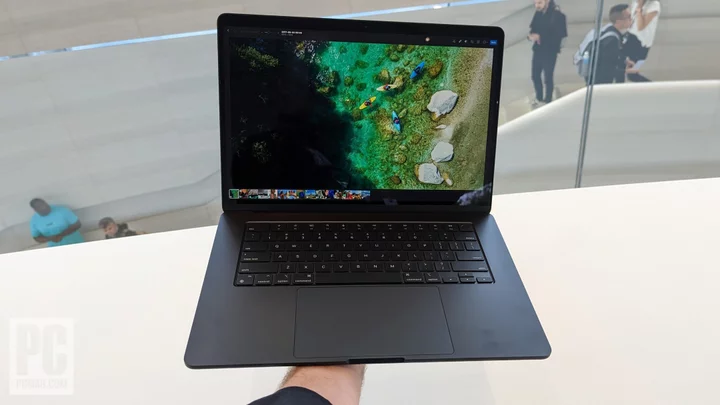During its WWDC 2023 keynote, Apple threw down a gauntlet to the laptop world with the 15-inch MacBook Air. Why put this in such dramatic terms? It’s because of the price: just $1,299 for the base model. Okay, that sounds like every other luxury-priced Apple laptop, right? Wrong.
This $1,299 price puts the 15-inch MacBook Air right in line with many of the leading flagship Windows laptops—with 15-inch screens, or otherwise. Generally speaking, up until this point, it took months of time on the shelves before the latest Apple laptops dropped in price closer to that of competing Windows laptops. So, what gives, and how did this happen?
Sizing Up the New MacBook Air
Apple’s new 15-inch MacBook Air comes in four colors, including an all-black option, and at that starting price, you get Apple’s proven M2 processor backed up by 8GB of memory and a 256GB SSD. That’s all accessed through a 15.3-inch Liquid Retina IPS display (native resolution 2,880 by 1,864 pixels, and rated for up to 500 nits of brightness, per Apple claims).
The 15-inch MacBook Air in various stages of fold...for some reasonAccording to Apple, the new 15-inch laptop will last for up to 15 hours of wireless internet use, which is on par with most Windows-based laptops of its size. Now, you miss out on support for Wi-Fi 6E, with just Wi-Fi 6 available, but you do get a 1080p FaceTime webcam and two Thunderbolt 4 ports (the same as with the 13-inch model).
Finally, with the panel color coverage often found on MacBook displays, you’re looking at a quite-capable multimedia editing device with a decently sized screen, without having to make the big leap in price to the MacBook Pro line at this relative size.
Let’s Look at the Windows Competition
As for what you can find among flagship laptops running on Windows 11, a powerful contender is the latest $1,299 Dell XPS 15 from one of the big names in Windows laptops. At that starting price, you get a 13th Gen Intel Core i7 CPU with Intel Arc 370M graphics, a superior 16GB of RAM, and a larger 512GB SSD. However, it comes with a mere 1,920-by-1,200-pixel 15.6-inch display and a paltry 720p webcam by comparison. (A 15-inch MacBook Air with a 512GB SSD costs $1,499, keeping everything honest.)
Likewise, the Lenovo Yoga 9i starts at a slightly higher $1,399, which nets you a similar chip to the Dell as well as identical amounts of RAM and SSD space. However, Lenovo gets closer in quality with its 14-inch 2,880-by-1,800-pixel touch screen and Apple-matching 1080p webcam, and you get the kind of 2-in-1 convertibility no MacBook has ever offered.
Dell's latest XPS 15 has an identical starting price, and it doesn't offer as much.Finally, we have a comparable laptop from Apple’s most famous rival in the phone world, Samsung, in the form of the Galaxy Book3 Pro. It starts at $1,449. While it was likely initially propped up against Apple’s MacBook Pro, the new 15-inch MacBook Air changes that calculus. The 14-inch Galaxy Book3 Pro—a 16-inch model is sold for $1,749 to start—uses a similar processor and equal amounts of RAM and SSD capacity as the aforementioned laptops with a display similar in size, sharpness, and capabilities to Lenovo’s Yoga screen. (You could also throw the recent $1,499 Acer Swift Edge 16 into this comparison, but I won’t belabor the point.)
All told, nothing I could find from the leading manufacturers of 15-inch Windows laptops (or even 14-inch flagship models, clearly) bests on every front what Apple is now selling for $1,300. While the 15-inch MacBook Air has half as much memory and storage to start, comparatively, remember that Apple’s unified memory approach is directly optimized for use with macOS, all of which it controls. If you need the 16GB/512GB RAM/SSD combo, then the $1,499 price remains competitive with all other features considered.
An 'Apple Tax Break?' How Did This Happen?
With Apple's MacBooks for so long considered a premium-priced option for laptops, how did the 15-inch Air suddenly become directly comparable with its competitors? (The “Apple Tax” is a meme for a reason.)
While it’s difficult to say with 100% certainty, this looks a lot like the result of Apple bringing just about every piece of its Mac development and manufacturing stack in-house or white-labeled, notably the providers of its internal components. Apple owns just about 100% of its Apple Silicon processors and memory, save for their actual fabrication. This means Apple doesn’t have to buy its processors from a provider in competition with other OEMs, but rather pay a fabricator to produce them to its own spec, which makes a big difference in terms of leverage when negotiating prices. When Apple had to pay Intel for its Core chips, imagine the position that Apple was in at the negotiation table, knowing that no viable alternatives existed, for all that time.
This 15-inch MacBook Air could shake up the market on price alone.So, without this expense to Intel, and a better-leveraged position from which to provide its Mac computers with processors, it’s likely that Apple can afford to sell its Mac computers for less than before and maintain its profit margins. For instance, in the same breath that it announced the 15-inch MacBook Air, Apple slashed $100 off the latest 13-inch MacBook Air, to $1,099. A company doesn’t do that unless it can afford to and not lose money.
Meanwhile, makers of Windows-based laptops will continue to have to buy their core silicon components from providers like Intel and AMD, so it might become increasingly difficult for them to compete on price against Apple. That's a new one! The Mac-versus-PC debate could get deeply interesting over the next few years.

